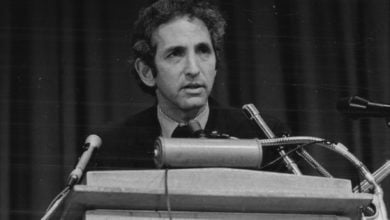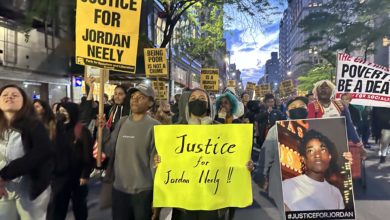Rev. Fred L. Shuttlesworth,
stalwart civil rights movement leader, died Oct. 5 at the age of 89.
Shuttlesworth rose to prominence by continuing civil rights activity in Alabama
following the 1956 banning of the NAACP by state officials.
Present at virtually every major
event in Alabama civil rights history of the 1950s and 1960s, Shuttlesworth
gained broad respect for his willingness to brave the gravest of consequences
with no regard to his own life. Most noted for his role in Birmingham’s 1963
“Children’s Crusade,” Shuttlesworth was an important supporter of the Freedom
Rides. He also accompanied Autherine Lucy as she enrolled as the first Black
student at the University of Alabama in 1956.
A two-time victim of bombings and
numerous beatings, Shuttlesworth once survived a bomb attack in which six sticks
of dynamite were used. When he attempted to enroll his daughters at an
all-white school, he was beaten multiple times with chains and brass knuckles,
and by his own account was “almost at death’s door.” On the militant,
aggressive edge of the non-violent section of the movement, Rev. Shuttlesworth
sought to inspire bold action, which also gave him a reputation as a sometime
abrasive ally.
Humble beginnings
Rev. Shuttlesworth was born in the
Alabama backwoods in 1922 to a family that made a living sharecropping and
bootlegging. In 1940, he was convicted of running a still and received two
years probation. Throughout the 1940s, he moved around the state working as a
truck driver and cement worker. Towards the end of the decade, he settled into
full-time preaching, got married and built his own home out of scrap. By 1953,
Shuttlesworth was pastor at Birmingham’s Bethel Baptist church, and an active
member of the state’s NAACP.
In 1956, however, the NAACP was
effectively banned in Alabama and wound down operations. Already frustrated by
organizational obstacles in the NAACP, Shuttlesworth seized the opportunity to
fill the void in Alabama with a new civil rights organization, the Alabama
Christian Movement for Human Rights. Later in the decade, he was central to the
founding of the Southern Christian Leadership Conference. Stressing the need
for mass action, Shuttlesworth fearlessly engaged in actions of small groups
and sometimes of just himself, looking to set inspirational sparks.
Shuttlesworth was often at odds
with the urban Black elites who had made their own accommodation with Jim Crow.
He and other civil rights leaders devoted to mass action to smash segregation
had to look to the broad mass of working-class and poor Blacks and grade-school
youth, buoyed by college crusaders. The domestic workers, the sharecroppers and
the high school students who filled jails—these were the backbone of the
Alabama struggle in the early 1960s.
In the eye of the storm
Shuttlesworth’s centrality to the
Birmingham movement made him a crucial ally of the Freedom Riders in 1961. The
Freedom Rides electrified the nation as groups of students braved threats and
violence to test court rulings on desegregation in interstate travel. On
Mothers Day, May 14, the Freedom Riders arrived in Birmingham. For weeks prior,
Shuttlesworth had warned of a Klan ambush, the threat of which was an open secret
in the city.
Birmingham was known at that time
as a seat of Jim Crow terrorism, with one of the South’s most vicious law
enforcement officials, Eugene “Bull” Connor. Connor had begun his career
breaking strikes and hounding communists in 1930s Birmingham, and was a zealous
opponent of civil rights activity. Connor and the Klan were determined to stop
the Freedom Rides in Birmingham, so Connor promised the KKK 15 minutes of
complete freedom to attack the Freedom Riders in the bus terminal.
Once the melee began,
Shuttlesworth’s home became an impromptu mobilization center that people at the
bus station called for help; it was where reinforcements were dispatched and
where protesters who escaped the violence sought shelter. Organizers from
Shuttlesworth’s ACMHR rescued Freedom Riders trapped in and near the bus
terminal. Shuttlesworth went on helping coordinate logistics with student
leaders in Nashville as well as getting arrested himself in a struggle that
kept the Freedom Rides going.
Shuttlesworth is most associated
with his role in the events around the “Children’s Crusade” of 1963. With his
developed network in the city, Shuttlesworth joined with Martin Luther King Jr
to turn Birmingham into a watershed moment for the movement. In his words, “We
were trying to launch a systematic, wholehearted battle against segregation,
which would set the pace for the nation.”
However, the movement was slow to
pick up momentum, with almost uniform opposition from the urban Black elites,
optimistic that the triumph of white “liberals” in recent elections would usher
in an era of slow and steady desegregation. Students from elementary to high
school, not content to wait and skeptical of promises from politicians, became
increasingly involved in the movement. They filled jails to their capacity and
scandalized the world as pictures of dogs and fire hoses being unleashed on
children filtered out through the media.
While leading one protest,
Shuttlesworth was hit in the chest and taken away in an ambulance. Upon hearing
that news, Bull Connor publicly remarked that he wished Shuttlesworth had been
taken away in a hearse. It was Connor, however, who was carted off as the
Birmingham movement broke down the wall of segregation and electrified the
civil rights movement, injecting the issue into the center of the nation’s
consciousness.
Rev. Shuttlesworth remained
involved in civil rights issues, including a failed attempt at reinvigorating
the SCLC, basing himself out of Cincinnati. Unfortunately, in 2004 he lent his name
to an effort to block a gay rights ordinance. He died in Birmingham, where he
had relocated following a stroke in 2008, leaving behind a legacy with much to
admire and emulate.






